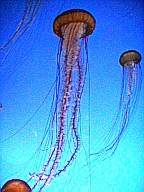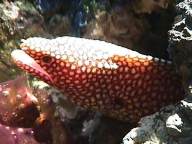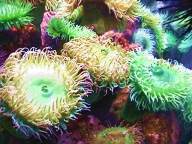With the debut of its
award-winning Outer Bay galleries, it became the first aquarium
in the world to create open ocean exhibits on a grand scale.
Giant ocean sunfish, sharks, tunas and turtles roam the
million-gallon Outer Bay exhibit, visible through the largest
window on Earth. It is the dramatic centerpiece of the Outer Bay
galleries. In addition to that Karen took us to two other great
galleries. The first was entitled "Mysteries of the Deep" which
explores deep sea habitats as it takes visitors on a tour of the
Monterey submarine canyon. This is the largest undersea canyon on
the west coast of the United States. At the head of the canyon
offshore of Moss Landing, it's less than 33 feet deep. At its
mouth, it's 12,730 feet deep. Within the bay, the canyon is as
deep and as steep as the Grand Canyon of Arizona. Unprecedented
live exhibits, videos and hands-on displays carry visitors
through the three major deep sea habitats found in the bay: the
canyon walls, representative of vertical rock faces in the deep
sea, the mid-water, a dark ocean realm with no solid surface,
found between sunlit surfaces waters and the bottom, and the
canyon floor, representative of the deep sea floor. The live
exhibits feature between 40 and 60 species of animals - most of
them never before seen in an aquarium. Visitors will see mushroom
corals, predatory tunicates, sea whips, spider crabs, filetail
"Mysteries of the Deep" which
explores deep sea habitats as it takes visitors on a tour of the
Monterey submarine canyon. This is the largest undersea canyon on
the west coast of the United States. At the head of the canyon
offshore of Moss Landing, it's less than 33 feet deep. At its
mouth, it's 12,730 feet deep. Within the bay, the canyon is as
deep and as steep as the Grand Canyon of Arizona. Unprecedented
live exhibits, videos and hands-on displays carry visitors
through the three major deep sea habitats found in the bay: the
canyon walls, representative of vertical rock faces in the deep
sea, the mid-water, a dark ocean realm with no solid surface,
found between sunlit surfaces waters and the bottom, and the
canyon floor, representative of the deep sea floor. The live
exhibits feature between 40 and 60 species of animals - most of
them never before seen in an aquarium. Visitors will see mushroom
corals, predatory tunicates, sea whips, spider crabs, filetail catsharks,
and ratfish along with many more not mentioned. In addition to
one of a kind live exhibits and other elements in the deep sea
galleries, the aquarium debuts an expanded daily program of live
video broadcasts from deep sea robot research subs that are
exploring the Monterey submarine canyon. During half-hour
programs presented six to eight times a day, "Exploring
Monterey Canyon" lets visitors peek over the shoulders of
research scientists from the Monterey Bay Aquarium Research
Institute (MBARI), an independent sister institution of the
aquarium during actual deep sea research dives.
catsharks,
and ratfish along with many more not mentioned. In addition to
one of a kind live exhibits and other elements in the deep sea
galleries, the aquarium debuts an expanded daily program of live
video broadcasts from deep sea robot research subs that are
exploring the Monterey submarine canyon. During half-hour
programs presented six to eight times a day, "Exploring
Monterey Canyon" lets visitors peek over the shoulders of
research scientists from the Monterey Bay Aquarium Research
Institute (MBARI), an independent sister institution of the
aquarium during actual deep sea research dives.  Deep-sea
ecosystems such as Monterey Bay's submarine canyon represent the
single largest habitat for life on Earth: more than three
quarters of the planet's total living space. Yet most of this
vast realm remains a mystery. The deep sea is by far the least
explored habitat in the world. The last gallery we visited was
called "Splash Zone". This colorful, hands-on gallery
is like a children's museum inside an aquarium. Here live animal
experiences are blended with hands-on learning in new and
exciting ways. Designed for families with children from infants
up to around 9 years old, "Splash Zone" features nearly
60 species, from South African blackfooted penguins to leafy sea
dragons. Over 30 hands-on exhibits,
Deep-sea
ecosystems such as Monterey Bay's submarine canyon represent the
single largest habitat for life on Earth: more than three
quarters of the planet's total living space. Yet most of this
vast realm remains a mystery. The deep sea is by far the least
explored habitat in the world. The last gallery we visited was
called "Splash Zone". This colorful, hands-on gallery
is like a children's museum inside an aquarium. Here live animal
experiences are blended with hands-on learning in new and
exciting ways. Designed for families with children from infants
up to around 9 years old, "Splash Zone" features nearly
60 species, from South African blackfooted penguins to leafy sea
dragons. Over 30 hands-on exhibits,  staff-led educational programs and specially
designed play areas will engage the imaginations of the young
visitors. The "Splash Zone" takes families on an
interactive tour through two contrasting shoreline habitats. The
Crowded Coral Reefs of tropical waters and the Rough Rocky Shore
found in cool temperate regions. Our tour of the Splash Zone
ended on a high note. Over a dozen blackfooted penguins from
South Africa awaited us behind a huge window in a display that
included a waterfall. We watched as these temperate-water
penguins swam and hopped around their rough and tumbling rocky
shore home, as Mark Faulkner worked through their feeding
schedule with Mary Ann Wilson keeping exact records as to what
was eaten by whom. Through the entire tour, Karen was a walking
encyclopedia of facts and figures not to mention her insight into
the trials and tribulations of operating such an elaborate and
very unique enterprise.
staff-led educational programs and specially
designed play areas will engage the imaginations of the young
visitors. The "Splash Zone" takes families on an
interactive tour through two contrasting shoreline habitats. The
Crowded Coral Reefs of tropical waters and the Rough Rocky Shore
found in cool temperate regions. Our tour of the Splash Zone
ended on a high note. Over a dozen blackfooted penguins from
South Africa awaited us behind a huge window in a display that
included a waterfall. We watched as these temperate-water
penguins swam and hopped around their rough and tumbling rocky
shore home, as Mark Faulkner worked through their feeding
schedule with Mary Ann Wilson keeping exact records as to what
was eaten by whom. Through the entire tour, Karen was a walking
encyclopedia of facts and figures not to mention her insight into
the trials and tribulations of operating such an elaborate and
very unique enterprise.  From her we learned that over 1.7 million people
visit the 322,00 square-foot aquarium annually. Some 450 full and
part time employees and around 900 volunteers make up the staff
needed for all the different aspects that has become part of the
Aquarium's daily life. Laura stopped to look at a starfish which
Carol Englehorn, a 13 year veteran volunteer was preparing for
one of the hands on displays. Carol described the volunteer
program as a big family where there are always friends around
you. Although Julie Packard still holds the reins as the
Aquarium's Executive Director, the operation is now self-funding,
without the assistance of government subsidies. The old movie
line "If you build it they will come" has proven to be
a sound financial principal here. It's a spectacle you just can't
see anywhere else. I put it on my "must see" travel
list for all of North America.
From her we learned that over 1.7 million people
visit the 322,00 square-foot aquarium annually. Some 450 full and
part time employees and around 900 volunteers make up the staff
needed for all the different aspects that has become part of the
Aquarium's daily life. Laura stopped to look at a starfish which
Carol Englehorn, a 13 year veteran volunteer was preparing for
one of the hands on displays. Carol described the volunteer
program as a big family where there are always friends around
you. Although Julie Packard still holds the reins as the
Aquarium's Executive Director, the operation is now self-funding,
without the assistance of government subsidies. The old movie
line "If you build it they will come" has proven to be
a sound financial principal here. It's a spectacle you just can't
see anywhere else. I put it on my "must see" travel
list for all of North America.
For more information about this adventure, check out http://www.mbayaq.org

